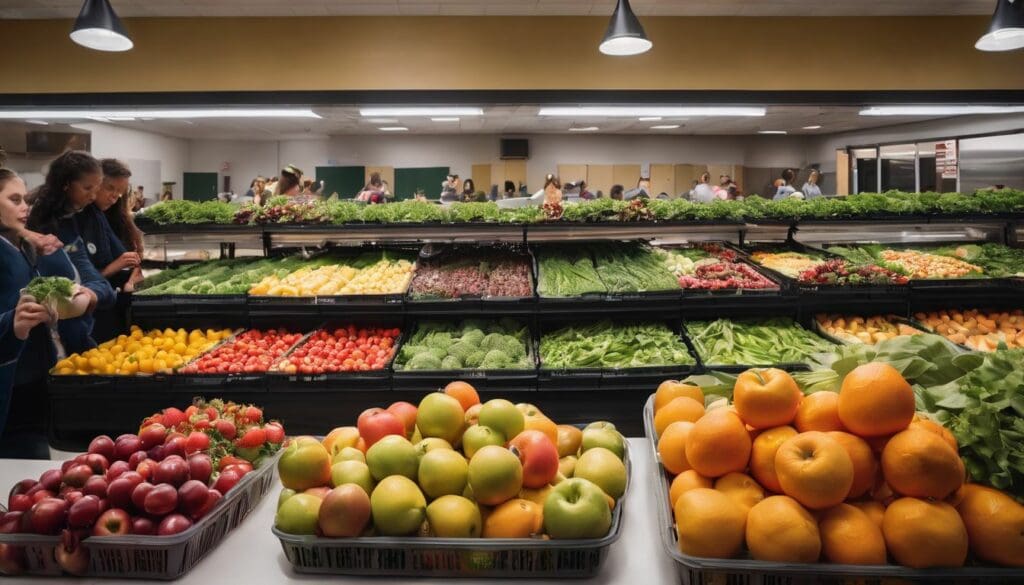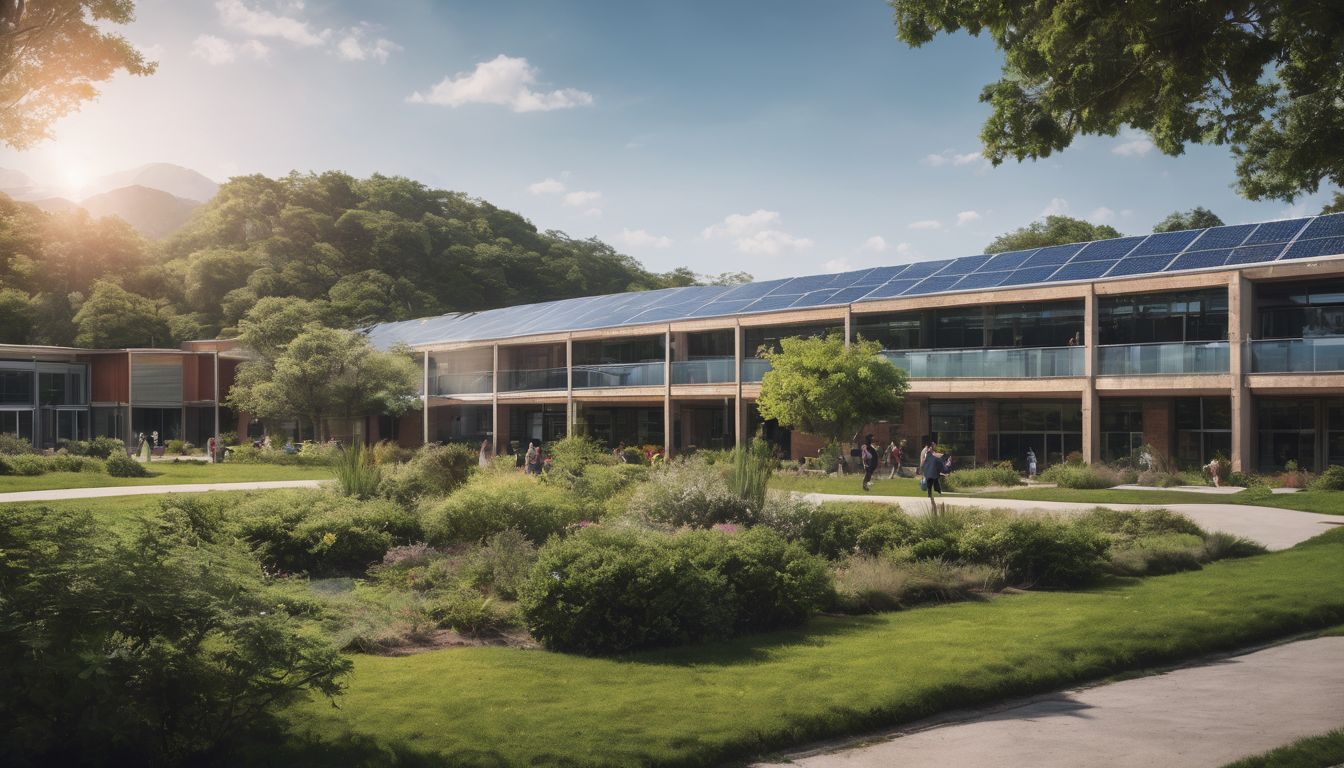School lunches might not always be as green as the salads they serve. Over a third of food in schools can end up wasted, affecting both our planet and budgets. This article serves up fresh ideas to bring sustainable practices into the bustling hub of school cafeterias, making meals that are healthy for both students and Earth.
Dive in to taste change!
Key Takeaways
- Schools can fight climate change and cut costs by sourcing local produce, reducing the use of single-use plastics, and promoting plant-based meals.
- Sustainable food systems in cafeterias improve student nutrition and teach them about environmental responsibility through hands-on learning like school gardens.
- Waste reduction strategies such as composting help schools manage food waste effectively; going paperless also reduces the cafeteria’s ecological footprint.
- Student involvement is essential; educating them about sustainable choices encourages them to advocate for eco-friendly practices at home and in their community.
- Success stories from various schools illustrate that implementing sustainable food systems leads to positive outcomes for both students’ health and the community.
Benefits of Sustainable Food Systems in School Cafeterias
Sustainable food systems in school cafeterias can lead to reduced greenhouse gas emissions and improved nutrition for students. Engaging students in sustainability can also create awareness and a sense of responsibility towards the environment.
Reduced greenhouse gas emissions
School cafeterias adopting sustainable food systems play a pivotal role in slashing greenhouse gas emissions. By sourcing locally-grown produce and embracing farm-to-school programs, transportation distances shrink, leading to fewer carbon dioxide releases from delivery vehicles.
Menus rich in plant-based options also contribute significantly; they require less energy and resources to grow than animal-derived foods, effectively cutting down the school’s carbon footprint.
Switching to methods that support environmental sustainability not only aids the planet but paves the way for improved nutrition among students – our next point of focus.
Improved nutrition for students
Students benefit from improved nutrition when school cafeterias prioritise sustainable food systems. By serving locally sourced, nutritious meals, students obtain essential vitamins and minerals crucial for healthy development.
This also supports food security within the community and promotes healthy eating habits among students. Additionally, educating students on farm-to-school programmes and incorporating environmental messaging into dietary interventions further enhances their understanding of sustainable nutrition and its importance in their daily lives.
Implementing sustainable food procurement practices not only benefits the environment but also has a direct positive impact on student health. By offering eco-friendly school lunches with an emphasis on nutritious ingredients, schools contribute to reducing greenhouse gas emissions while ensuring that students receive well-balanced and wholesome meals without compromising taste or variety.
Engaging students in sustainability
Introducing sustainability concepts in the curriculum can familiarise students with eco-friendly practices. Encouraging participation in school garden projects and waste reduction initiatives can foster a sense of responsibility towards the environment.
Involving students in decision-making processes for sustainable cafeteria practices cultivates their understanding of food systems and encourages them to adopt environmentally friendly habits.
Implementing interactive educational sessions on sustainable food systems equips students with practical knowledge about making eco-conscious choices. Providing opportunities for student-led sustainability campaigns empowers them to take active roles in promoting environmental stewardship within their school communities.
Strategies for Implementing Sustainable Food Systems
Serving sustainable foods, reducing single-use items, and starting a school garden are effective ways to implement sustainable food systems in school cafeterias. Educating students on the food system and incorporating environmental messaging into dietary interventions also play a crucial role in promoting sustainability.
Serve sustainable foods
School canteens can serve sustainable foods by sourcing locally grown produce, promoting eco-friendly farming practices, and using organic ingredients in meal preparation. By incorporating sustainably sourced meats and dairy products, schools can reduce their carbon footprint while supporting local farmers within the community.
This not only provides students with healthier, fresher food options but also teaches them about environmental sustainability and the benefits of consuming locally produced goods. By featuring sustainable food options on school menus and highlighting their positive impact on the environment, students are encouraged to make more environmentally conscious choices when it comes to their own dietary habits.
In addition to serving sustainable foods in school canteens, educators can also use this as an opportunity for teaching moments by sharing information about where the food comes from and why it matters.
Reduce single-use items
Implementing sustainable food systems in school canteens involves taking steps to reduce single-use items. By eliminating disposable plastics, cutlery, and packaging, schools can significantly minimise waste generation.
Introducing reusable containers, utensils, and water bottles not only decreases the environmental impact but also saves costs in the long run. Encouraging students to use refillable items and promoting eco-friendly alternatives can create a culture of sustainability within the school community.
By reducing single-use items such as plastic bags, straws, and containers, schools contribute to a healthier environment while teaching students about the importance of conservation.
Go paperless
Schools can make a significant impact on sustainability by going paperless in their canteen operations. This means replacing paper menus, order forms, and other paperwork with digital alternatives.
By doing so, schools can reduce their environmental footprint by saving trees and minimising waste. Going paperless also allows for easier communication between the canteen staff, students, and parents while promoting eco-friendly practices within the school community.
Furthermore, embracing a paperless approach aligns with the broader goal of creating environmentally sustainable food systems in school canteens. It not only reduces reliance on single-use items but also sets an example for students about how small changes can lead to big environmental benefits.
Start a school garden
Initiate a school garden to provide hands-on learning opportunities for students about sustainable food production. Engaging in gardening activities can teach students the importance of locally sourced foods and reduce reliance on long-distance food transportation, contributing to lower greenhouse gas emissions.
School gardens also offer the chance to grow fresh produce, which can be utilised in cafeteria meals, promoting sustainable nutrition while minimising food waste. Additionally, community gardens foster a sense of environmental stewardship and collaborative effort among students, supporting agricultural education and sustainable school meal preparation.
By establishing a school garden, educators have an opportunity to instil values of environmental sustainability and conservation in the next generation while actively contributing towards reducing carbon footprint through eco-friendly practices within school premises.
Educate students on the food system
Teach students about the food system to foster awareness. Integrate educational programs into the curriculum. Provide hands-on experiences such as school garden projects, cooking classes, and field trips to local farms.
Use interactive resources like documentaries and guest speakers to inspire interest in sustainable food practices among students.
Encourage critical thinking by exploring topics such as food production, distribution, nutrition, and environmental impact. Offer opportunities for students to participate in decision-making processes within the cafeteria and school-wide sustainability initiatives.
Incorporate environmental messaging into dietary interventions
To promote sustainability in school cafeterias, integrate environmental messaging into dietary interventions. Educate students about the impact of their food choices on the environment and encourage them to make eco-friendly decisions when selecting meals.
Engaging with local farmers and suppliers for sustainable food options fosters a connection between students and the source of their meals, creating awareness about the importance of supporting environmentally friendly practices.
By actively involving students in understanding and participating in sustainable food systems, schools can cultivate a generation that prioritises eco-conscious decision-making.
Encouraging environmentally conscious behaviour through dietary interventions enables schools to instil values of sustainability in students while contributing to positive changes in school cafeteria practices.
Challenges and Solutions
Managing food waste, ensuring cost-effectiveness, and addressing picky eaters are all challenges in implementing sustainable food systems in school cafeterias. Read more to discover the solutions to these challenges and how schools have successfully overcome them.
Food waste management
School canteens can implement food waste management strategies to reduce the amount of discarded food. By monitoring and adjusting portion sizes, schools can minimise excess food that often ends up in the bin.
Composting organic waste is another effective solution, turning leftovers into nutrient-rich soil for school gardens. Through education and awareness campaigns, students can also be involved in reducing food waste by learning about responsible consumption and disposal.
To further decrease food waste, schools should consider implementing meal planning techniques to ensure that only necessary ingredients are ordered. Additionally, establishing partnerships with local shelters or charities enables unused meals to be donated instead of being thrown away.
Cost-effectiveness
School cafeteria sustainable food systems are cost-effective, with benefits that outweigh the initial investment. By sourcing local and seasonal produce, schools can save on transportation costs and reduce their carbon footprint.
Additionally, eliminating single-use items and implementing food waste reduction strategies can lead to long-term savings. The initial cost of starting a school garden or incorporating eco-friendly practices may seem daunting, but in the long run, it pays off through reduced expenses and a positive impact on the environment.
Sustainable nutrition in schools provides an opportunity for resourcefulness and creativity in menu planning. Schools can work with local farmers to obtain fresh produce at lower costs and create enticing meals that appeal to students’ taste preferences while also meeting nutritional requirements.
Dealing with picky eaters
Picky eaters can pose a challenge when trying to introduce sustainable food systems in school cafeterias. Encouraging them to try new, eco-friendly options requires patience and creativity.
Involving students in the meal planning process and offering a variety of locally sourced, sustainable foods can help expand their palates. It’s essential to provide clear information about the benefits of sustainability and healthy eating, empowering students to make informed choices.
By devising engaging educational activities such as taste tests or farm visits, schools can foster a deeper understanding of where food comes from and how it impacts the environment.
By appealing to their sense of curiosity and adventure, picky eaters may become more open to embracing sustainable school meals.
Success Stories
Discover how schools around the country have successfully implemented sustainable food systems in their cafeterias, making a positive impact on students and the community. Learn about the benefits of these initiatives and how they are inspiring future generations to make environmentally conscious choices.
Schools with successful sustainable food systems
- Sourcing locally grown produce and ingredients, reducing food miles and supporting local farmers. This helps in increasing the freshness and sustainability of the food served.
- Engaging students in growing and harvesting their own fruits and vegetables through school gardens, fostering a deeper understanding of where food comes from and promoting environmental stewardship.
- Implementing waste reduction initiatives such as composting organic materials and recycling, minimising the environmental impact of cafeteria operations.
- Collaborating with local vendors to procure sustainably sourced seafood, meat, and dairy products, ensuring that the food served aligns with sustainable practices.
- Offering educational programmes that teach students about healthy eating habits, nutrition, and the importance of sustainable food choices, empowering them to make informed decisions about their meals.
- Incorporating plant – based menu options to reduce the environmental footprint of school cafeterias while promoting healthier dietary choices among students.
- Partnering with organisations to advocate for policy changes that support sustainable school food procurement, thereby creating a broader impact within the community.
Impact on students and the community
Implementing sustainable food systems in school cafeterias has a positive impact on students and the community. Students learn about the importance of environmentally friendly practices, such as reducing food waste and choosing locally sourced foods, leading to greater awareness of sustainable living.
They are empowered to make healthier choices with improved nutrition from fresh, eco-friendly meal options, positively impacting their overall well-being. Additionally, engaging in sustainability initiatives fosters a sense of responsibility towards the environment within the school community, creating a ripple effect that extends beyond the campus.
By embracing sustainable food systems, schools contribute to reducing greenhouse gas emissions while supporting local farmers and businesses. This not only strengthens ties within the community but also sets an example for other institutions and encourages wider adoption of eco-friendly practices.
Conclusion
Sustainable food systems in school cafeterias benefit students and the environment. Implementation of strategies such as serving sustainable foods and reducing single-use items can lead to a significant reduction in greenhouse gas emissions.
Success stories from schools with successful sustainable food systems show the positive impact on students and the community, proving that eco-friendly practices are achievable and impactful.
It’s time for more schools to embrace green cafeteria practices for a healthier planet and future generations.
FAQs
1. What are sustainable food systems in school cafeterias?
Sustainable food systems in school cafeterias focus on serving eco-friendly school lunches, where meals come from local sources and waste is kept to a minimum.
2. Why should schools have green cafeteria practices?
Green cafeteria practices help reduce environmental impact by cutting down on waste and supporting sustainable nutrition in schools, making it better for the planet.
3. How can farm-to-school programs benefit students?
Farm-to-school programs connect schools with local farms to supply fresh, locally sourced foods for healthy and sustainable school lunch menus.
4. Can reducing food waste also save money for schools?
Yes! By adopting methods of food waste reduction in schools, not only do they protect the environment but also cut costs by buying no more than what’s needed.
5. Are there groups working towards sustainable school food advocacy?
There are numerous advocates pushing for greater sustainability within school lunch programs who work hard every day to improve our kids’ health and their future environment.





